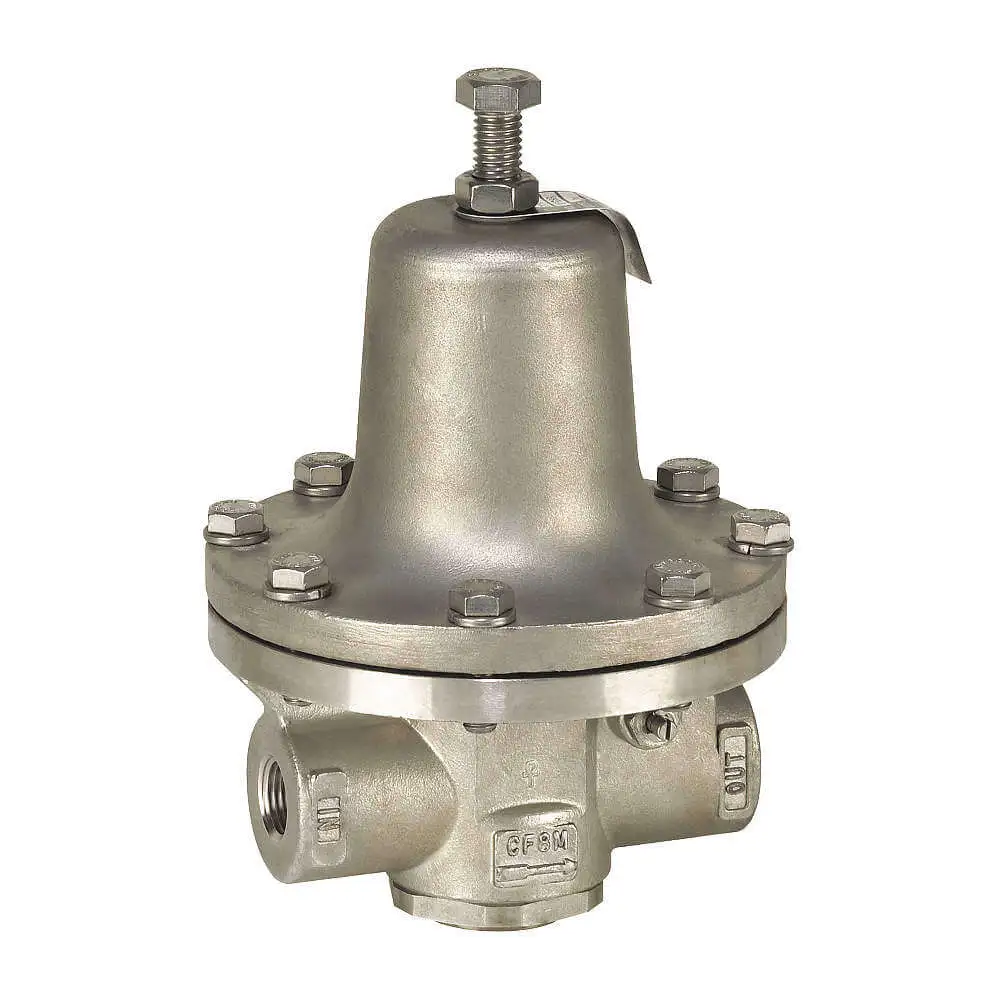152SS Series, Steam Pressure Regulator, For Steam
Watts 152SS Series steam pressure regulators are used to regulate steam pressure in autoclaves, steam tables / irons, vulcanisers and large capacity process services. These pressure regulators are highly sensitive to reduced pressure changes. Watts 152SS Series steam pressure regulators feature a stainless steel body with NPT threaded female inlet & outlet connections, stainless steel strainer & seat, stainless steel diaphragm, Teflon disc and sensitivity adjustment mechanism for critical flow. They provide full volume with minimum pressure drop and in-line serviceability, making them ideal for sterilisers, process lines, testing fixtures and oil lines. Raptor Supplies offers these steam pressure regulators in variants having a maximum supply pressure of 300 psi (21 bar) at 420 degrees F (216 degrees C).
Uses
Watts 152SS Series steam pressure regulators are ideal for oil lines, testing fixtures, autoclaves, steam tables, steam irons, single radiators, vulcanisers, sterilisers and process lines.
Working Mechanism
Watts 152SS Series steam pressure regulators precisely control the downstream pressure of steam. In addition to reducing supply (or inlet) pressure, these pressure regulators also maintain the outlet pressure despite fluctuations in the inlet pressure. Reduced inlet pressure results in reduced outlet pressure, which is a key characteristic of steam pressure regulators. When a gas or liquid reaches a certain pressure, these steam pressure regulators automatically cut off the flow. The primary function of Watts steam pressure regulators is to match the flow of liquid or gas by reacting to any changes in flow load. If the flow load increases, then these steam pressure regulators must also increase their own flow rate. Similarly, if the flow load decreases, they must also decrease their flow rate. This ensures that the pressure in the application remains controlled. Watts 152SS Series steam pressure regulators work by reducing the supply (or inlet) pressure to the outlet.
Features
- Watts 152SS Series steam pressure regulators feature a stainless steel body with stainless steel strainer, seat & diaphragm for use on sterilisers, process lines, fixtures and oil lines.
- These steam pressure regulators provide a highly sensitive response to reduced pressure changes, and have the ability to maintain full volume without appreciably reduced pressure drop.
- Watts steam pressure regulators are equipped with a sensitivity adjuster to eliminate vibrations that can arise due to critical flow requirements.
Standards and Approvals
Watts 152SS Series steam pressure regulators are built in accordance with ASSE, CSA, FM, NSF, UL, ULC, USC & WQA standards to ensure efficient performance of the regulators.
Installation
- Connect the pressure source and the regulated pressure line to the inlet port and outlet port, respectively.
- Turn off the adjustment control knob before turning on the supply pressure to the regulator in order to restrict the flow through the regulator. You should gradually turn up the supply pressure so as not to shock your regulator with a sudden surge of fluid pressure. Avoid turning the adjustment screw all the way into the regulator because, in some regulator designs, the full supply pressure will be delivered to the outlet port.
- The pressure regulator should be set to the desired outlet pressure. In case the measured outlet pressure is higher than the desired outlet pressure, vent the fluid from the downstream side of the regulator, and reduce the outlet pressure by turning the adjustment knob. Do not loosen fittings in an attempt to vent fluid.
- Make final adjustments by slowly increasing the pressure from below the desired set point until the desired outlet pressure is achieved.
- Monitor the outlet pressure while cycling the supply pressure on and off several times to confirm the regulator is consistently returning to its set point. To ensure that the pressure regulator returns to the desired set point, the outlet pressure should also be cycled on and off.
Frequently Asked Questions
Do steam pressure regulators restrict flow?
Steam pressure regulators are not designed to control flow rates. Although pressure regulators used in flowing systems inherently affect the flow by controlling the pressure, they are not designed to act as flow controllers.
What is the difference between a flow regulator and a pressure regulator?
Flow control valves are used for controlling and adjusting fluid or gas flow through the system. On the other hand, pressure control valves are used to regulate the pressure of a fluid passing through the pipe.
Where is the steam pressure regulator located?
The pressure regulator is generally located at the point where the local supply line connects to your home, just after your home's main shutoff point. This way, whenever you want to repair or replace the regulator, you can simply turn off the main valve.
What happens when a steam pressure regulator fails?
If you have a steam pressure regulator and it fails, you'll notice an immediate reaction in your home. For instance, you'll experience irregular water pressure that is hard to control, in your sink / toilet / bathtub faucets. The pressure would either be too high or too low.
What are the different types of pressure regulators?
- General purpose regulators: They are intended for industrial use and generally operate only above atmospheric pressure.
- High pressure regulators: They feature a robust design rated for inlet pressures higher than 1000 psi.
- Low pressure regulators: They are incorporated with special design characteristics for precise control of pressures below 20 psi.
- Vacuum or compound regulator: They are also known as an absolute pressure regulators and are designed to control fluid below atmospheric pressure.
- Differential or bias regulators: They are intended to maintain a pressure differential between two locations in the system.
 Change Country
Change Country